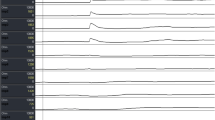Abstract
Background
Multiple rapid swallows (MRS) during HREM assess post-deglutitive inhibition, LES relaxation, and subsequent esophageal contraction.
Aims
(1) To determine the relationship between MRS and single-swallow (SS) responses and (2) to determine if MRS provides information for symptomatic patients.
Methods
Healthy volunteers (HVs) and patients underwent HREM [30-s landmark, ten 5-mL SS, MRS (5 consecutive 2-mL swallows every 2–3 s)] and were analyzed with ManoView software version 3 with CC version 3.0.
Results
In 20 HVs, MRS response consisted of: (1) reduction in GEJ pressure; (2) absence of esophageal contractile activity during MRS; and (3) post-MRS peristaltic contraction greater than SS contractions. In 20 HVs and 403 patients, MRS IRP correlated with SS IRP (r = 0.65; p < 0.0001) and post-MRS contraction DCI correlated with SS DCI (r = 0.76; p < 0.0001). Abnormally elevated MRS IRP was seen in 68% type 2 achalasia, 50% type 3 achalasia, 47% EGJOO, and 9% jackhammer. Increased MRS DCI was seen in 53% type 2 achalasia, 92% type 3 achalasia, 10% EGJOO, 22% jackhammer, and 18% DES. Increased DCI post-MRS was seen in 38% patients with jackhammer, 8% type 3 achalasia, 12% EGJOO, and 9% DES. 14 out of 143 (10%) patients with normal or indeterminate results on SS analysis had at least one abnormality on MRS.
Conclusions
MRS IRP correlated with SS IRP, and post-MRS DCI correlated with SS DCI. Patients with defined CC disorders have abnormalities on MRS. There were MRS abnormalities in some patients with normal SS studies, most notably suggesting impaired LES relaxation and/or spastic esophageal motility. MRS may complement the baseline SS study analysis.

Similar content being viewed by others
References
Bredenoord AJ, Fox MR. Oesophageal high-resolution manometry: moving from research into clinical practice. Gut. 2008;57:405–423.
International High Resolution Manometry Working Group. The Chicago classification of esophageal motility disorders, v3.0. Neurogastroenterol Motil. 2015;27:160–174.
Gyawali CP, Bredenoord AJ, Conklin JL, et al. Evaluation of esophageal motor function in clinical practice. Neurogastroenterol Motil. 2013;25:99–133.
Shaker A, Stoikes N, Drapekin J, Kushnir V, Brunt LM, Gyawali P. Multiple rapid swallow responses during esophageal high-resolution manometry reflect esophageal body peristaltic reserve. Am J Gastroenterol. 2013;108:1706–1712.
Woodland P, Gabieta-Sonmez S, Arguero J, et al. 200 mL rapid drink challenge during high-resolution manometry best predicts objective esophagogastric junction obstruction and correlates with symptom severity. Neurogastroenterol Motil. 2018;24:410.
Ang D, Hollenstein M, Misselwitz B, et al. Rapid drink challenge in high-resolution manometry: an adjunctive test for detection of esophageal motility disorders. Neurogastroenterol Motil. 2017;29:e12902.
Sifrim D, Jafari J. Deglutitive inhibition, latency between swallow and esophageal contractions and primary esophageal motor disorders. Neurogastroenterol Motil. 2012;18:6–12.
Savojardo D, Mangano M, Cantú P, Penagini R. Multiple rapid swallowing in idiopathic achalasia: evidence for patients’ heterogeneity. Neurogastroenterol Motil. 2007;19:263–269.
Price LH, Li Y, Gyawali CP. Reproducibility patterns of multiple rapid swallows during high resolution esophageal manometry provide insights into esophageal pathophysiology. Neurogastroenterol Motil. 2014;26:646–653.
Fornari F, Bravi I, Penagini R, Tack J, Sifrim D. Multiple rapid swallowing: a complementary test during standard oesophageal manometry. Neurogastroenterol Motil. 2009;21:718–725.
Stoikes ND. The value of multiple rapid swallows during preoperative esophageal manometry before laparoscopic antireflux surgery. Surg Endosc. 2012;26:3401–3407.
Xiao Y, Nicodème F, Kahrilas PJ, Roman S, Lin Z, Pandolfino JE. Optimizing the swallow protocol of clinical high resolution esophageal manometry studies. Neurogastroenterol Motil. 2012;24:e489–e496.
Author information
Authors and Affiliations
Contributions
AL conceived and designed the study; analyzed and interpreted the data; performed statistical analysis; and drafted the manuscript. DY performed statistical analysis; conceived and designed statistical analysis; analyzed and interpreted the data; and critically revised the manuscript. RB designed the study; interpreted the data; oversaw the analysis; and reviewed the manuscript. RK designed the study; interpreted the data; oversaw the analysis; and reviewed the manuscript. XL performed statistical analysis. AJ conceived and designed the study; interpreted the data; and reviewed the manuscript. MH collected the data and performed esophageal manometry. FF conceived and designed the study; interpreted the data; and reviewed the manuscript. ZM conceived and designed the study; interpreted the data; and reviewed the manuscript. RS conceived and designed the study; interpreted the data; and reviewed the manuscript. HPP conceived and designed the study; analyzed and interpreted the data; critically revised the manuscript for important intellectual content; and supervised the study.
Corresponding author
Ethics declarations
Conflicts of Interest
No conflicts of interest.
Additional information
Publisher's Note
Springer Nature remains neutral with regard to jurisdictional claims in published maps and institutional affiliations.
Rights and permissions
About this article
Cite this article
Leopold, A., Yu, D., Bhuta, R. et al. Multiple Rapid Swallows (MRS) Complements Single-Swallow (SS) Analysis for High-Resolution Esophageal Manometry (HREM). Dig Dis Sci 64, 2206–2213 (2019). https://doi.org/10.1007/s10620-019-05545-2
Received:
Accepted:
Published:
Issue Date:
DOI: https://doi.org/10.1007/s10620-019-05545-2




